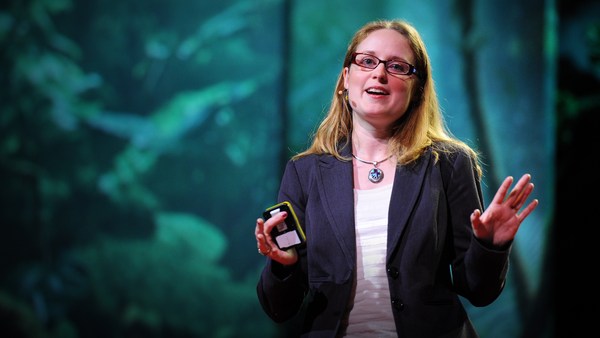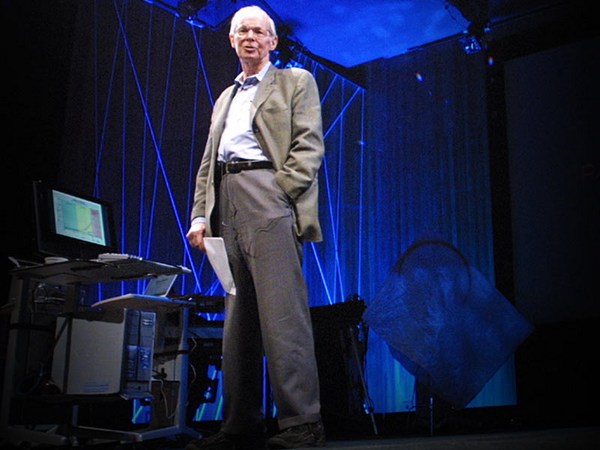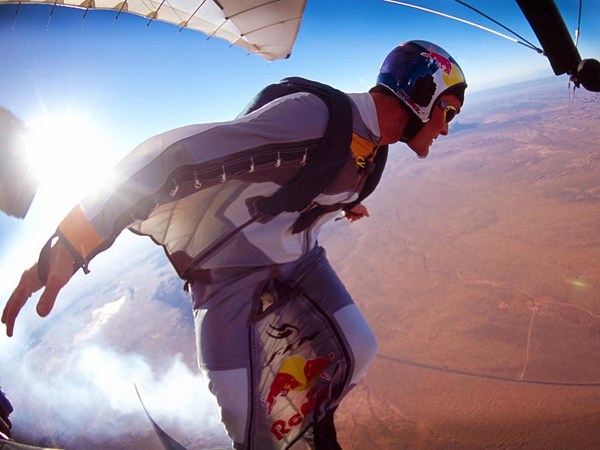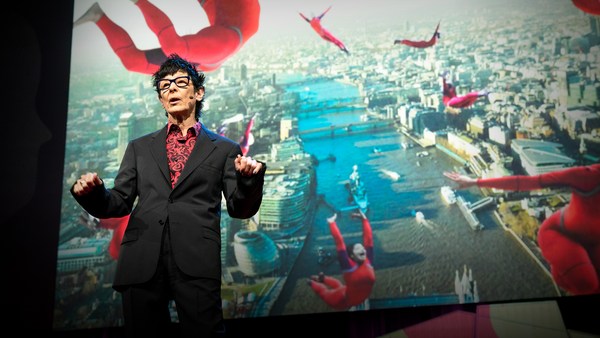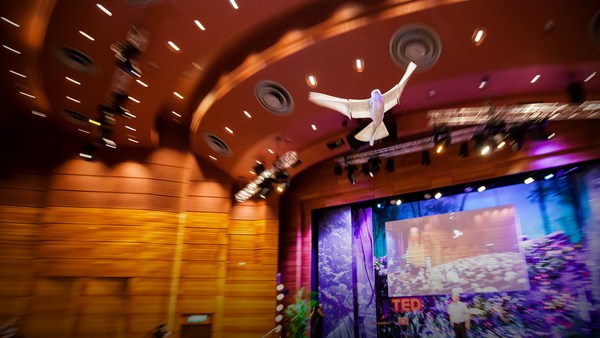(Music)
[music by Moby]
[Grand Canyon]
Narrator: Many of the tests are conducted while Yves is strapped onto the wing, because Yves' body is an integral part of the aircraft.
[Wind tunnel tests]
Narrator: The wing has no steering controls, no flaps, no rudder. Yves uses his body to steer the wing.
Stefan Von Bergen: Well, he turns by just putting his head on one or the other side. And sometimes he assists that with his hands, sometimes even with the leg. He's acting as a human fuselage, so to say. And that's quite unique.
Narrator: When he arches his back, he gains altitude. When he pushes his shoulders forward, he goes into a dive.
[Swiss Alps]
[Strait of Gibraltar crossing]
[English Channel crossing]
Commentator One: There he goes. There is Yves Rossy. And I think the wing is open. So our first critical moment, it's open. He is down. Is he flying?
Commentator Two: It looks like he's stabilized. He's starting to make his climb.
Commentator One: There's that 90 degree turn. He's out over the channel. There is Yves Rossy. There is no turning back now. He is over the English Channel and under way. Ladies and gentlemen, a historic flight has begun.
[Images: National Geographic]
Commentator Two: And as he approaches the ground, he's going to pull down on those toggles to flare, slow himself down just a little bit, and then come in for a nice landing.
Commentator One: There he is. Yves Rossy has landed in England.
Bruno Giussani: And now he's in Edinburgh. Yves Rossy!
(Applause)
(Applause ends)
And his equipment as well. Yves, welcome. It is quite amazing. Those sequences were shot over the last three years in various moments of your activities. And there were many, many others. So it's possible to fly almost like a bird. What is it like to be up there?
Yves Rossy: It's fun. It's fun.
(Laughter)
I don't have feathers. But I feel like a bird sometimes. It's really an unreal feeling, because normally you have a big thing, a plane, around you. And when I strap just this little harness, this little wing, I really have the feeling of being a bird.
BG: How did you start to become Jetman?
YR: It was about 20 years ago, when I discovered free falling. When you go out of an airplane, you are almost naked. You take a position like that. And especially when you take a tracking position, you have the feeling that you are flying. And that's the nearest thing to the dream. You have no machine around you. You are just in the element. It's very short and only in one direction.
(Laughter)
So the idea was, okay, keep that feeling of freedom, but change the vector and increase the time.
BG: So I'm kind of curious, what's your top speed?
YR: It's about 300 km per hour before looping. That means about 190 miles per hour.
BG: What's the weight of the equipment you're carrying?
YR: When I exit full of kerosene, I'm about 55 kilos. I have 55 kilos on my back.
BG: And you're not piloting? There is no handle, no steering, nothing? It is purely your body, and the wings become part of the body and vice versa?
YR: That's really the goal, because if you put in steering, then you reinvent the airplane. And I wanted to keep this freedom of movement. And it's really like the kid playing the airplane. I want to go down like that. And up I climb, I turn. It's really pure flying. It's not steering, it's flight.
BG: What kind of training do you do, you personally, for that?
YR: Actually, I try to stay just fit. I don't do special physical training. I just try to keep my mobility through new activities. For example, last winter I began with kite surfing. So, new things. So you have to adapt. I'm quite an experienced manager of systems as a pilot, but this is, really -- You need fluidity, you need to be agile and also to adapt really fast.
BG: Somebody in the audience asked me, "How does he breathe up there?" Because you're going fast and you're up at 3,000 meters or so.
YR: Okay, up to 3,000 meters, it's not such a big problem with oxygen. But for example, bikers, they have the same speed. Just with the helmet, integral helmet, it's really no problem to breathe.
BG: Describe for me the equipment, since you have it here. So Breitling's four engines.
YR: Yeah, two-meter span. Ultra-stable profile. Four little engines, 22 kilos thrust each, turbines, working with kerosene. Harness, parachute. My only instruments are an altimeter and time. I know I have about eight minutes fuel. So I just check before it's finished.
(Laughter)
And yeah, that's all. Two parachutes. That means, if I have a problem with the first one I pull, I still have the possibility to open the second one. And this is my life. That's the real important thing about safety. I did use that during these last 15 years about 20 times. Never with that type of wing, but at the beginning. I can release my wing when I am in a spin or unstable.
BG: We saw the 2009 crossing of the Gibraltar Strait where you lost control and then you dived down into the clouds and in the ocean. So that was one of those cases where you let the wings go, right?
YR: Yeah. I did try in the clouds, but you lose orientation completely. So I did try to take, again, a climb altitude. I thought, okay, I will go out. But most probably, I did something like that.
(Laughter)
BG: Something that is not very safe, the image.
YR: You feel great, but --
(Laughter)
But you have not the right altitude. So the next thing I saw was just blue. It was the sea. I have also an audible altimeter. So I was at my minimum altitude in that vector -- fast -- so I pulled that. And then I did open my chute.
BG: So the wings have their own parachute, and you have your two parachutes.
YR: Exactly. There is a rescue parachute for the wing for two reasons: so I can repair it afterward and especially so nobody takes that, just on his head.
BG: I see. Maybe come back here. This is risky stuff indeed. People have died trying to do this kind of thing. And you don't look like a crazy guy; you're a Swiss airline pilot, so you're rather a checklist kind of guy. I assume you have standards.
YR: Yeah. I have no checklist for that.
(Laughter)
BG: Let's not tell your employer.
(Laughter)
YR: No, that's really two worlds. Civil aviation is something that we know very well. We have a hundred years of experience. And you can adapt really precisely. With that, I have to adapt to something new. That means improvise. So it's really a play between these two approaches. Something that I know very well, these principles. For example, we have two engines on an Airbus; with only one engine, you can fly it. So plan B, always a plan B. In a fighter, you have an ejection seat. That's my ejection seat. So I have the approach of a professional pilot with the respect of a pioneer in front of Mother Nature.
BG: It's well said. What happens if one of the engines stops?
YR: I do a roll. And then I stabilize, and according to my altitude, I continue on two or three engines. It's sometimes possible. It's quite complicated to explain, but according to which regime I was, I can continue on two and try to get a nice place to land, and then I open my parachute.
BG: So the beginning of the flight is actually you jump off a plane or a helicopter, and you go on a dive and accelerate the engines, and then you basically take off mid-air somewhere. And then the landing, as we have seen, arriving on this side of the Channel, is through a parachute. So just as a curiosity, where did you land when you flew over the Grand Canyon? Did you land on the rim, down at the bottom?
YR: It was down on the bottom. And I came back afterward on the sled of the helicopter back. But it was too stony and full of cactus on top.
(Laughter)
BG: That's exactly why I asked the question.
YR: And also, the currents are quite funny there. There is big thermal activity, big difference in altitude also. So it was much safer for me to land at the bottom.
BG: I think that right now, many people are asking, "When are you developing a double-seater so they can fly with you?"
YR: I have a standard answer. Have you ever seen tandem birds?
(Laughter)
BG: Perfect answer.
(Applause)
(Applause ends)
BG: Yves, one last question. What's next for you? What's next for Jetman?
YR: First, to instruct a younger guy. I want to share it, to do formation flights. And I plan to start from a cliff, like catapulted from a cliff.
BG: So instead of jumping off a plane, yes?
YR: Yes, with the final goal to take off, but with initial speed. Really, I go step by step. It seems a little bit crazy, but it's not. It's possible to start already now, it's just too dangerous.
(Laughter) Thanks to the increasing technology, better technology, it will be safe. And I hope it will be for everybody.
BG: Yves, thank you very much. Yves Rossy.
(Applause)
